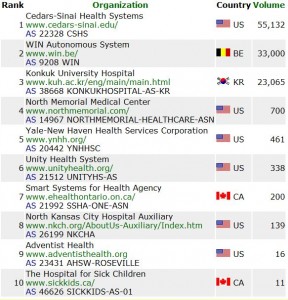 Here’s why to look at more than one spam data source:
according to the PSBL volume data for November 2011,
Cleveland Clinic’s AS 22093 CCF-NETWORK spewed more than a hundred
spam messages a day on multiple days, while
CBL volume data showed Cleveland Clinic with only 42 spam messages for the entire month.
Apparently PSBL’s spamtraps happened to be in the path of this CCF spam.
Here’s why to look at more than one spam data source:
according to the PSBL volume data for November 2011,
Cleveland Clinic’s AS 22093 CCF-NETWORK spewed more than a hundred
spam messages a day on multiple days, while
CBL volume data showed Cleveland Clinic with only 42 spam messages for the entire month.
Apparently PSBL’s spamtraps happened to be in the path of this CCF spam.

Now a couple of hundred spam messages a day isn’t much by world organization standards, but compared to what we’d all like to see from medical organizations (zero), it’s a lot.

 Also compared to the other medical institutions in the same rankings
from the same data,
the pie chart
looks like Pac Man and
the bar graph
looks like a hockey stick.
Also compared to the other medical institutions in the same rankings
from the same data,
the pie chart
looks like Pac Man and
the bar graph
looks like a hockey stick.
Maybe Cleveland Clinic didn’t get the memo after all.
-jsq











